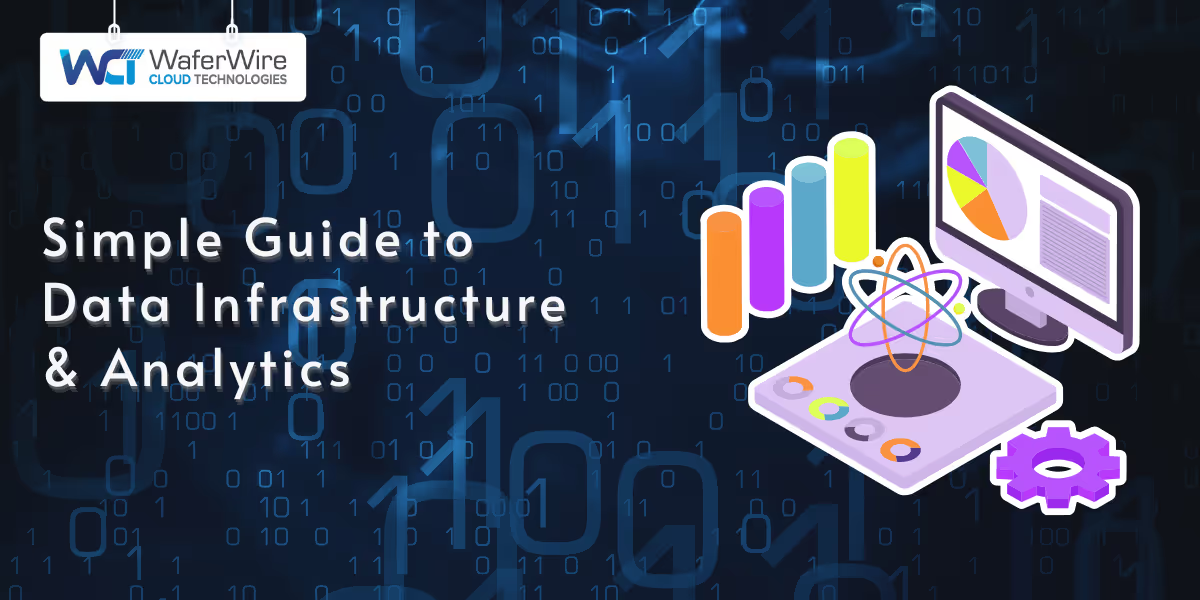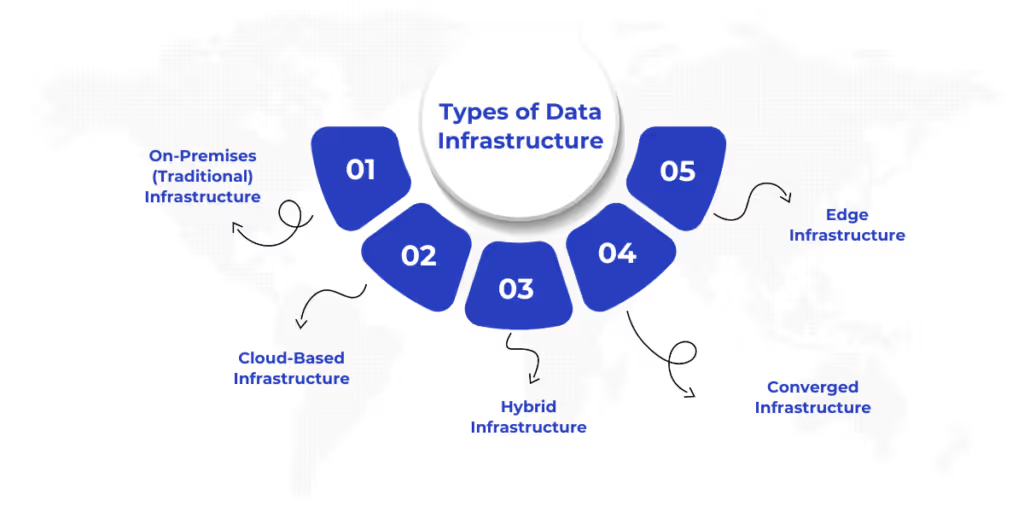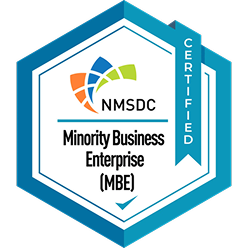

Organizations have focused on digital transformation for over twenty years, dedicating substantial time, energy, and resources to this endeavor. Statista said global digitalization expenditure hit $1.6 trillion in 2022.
Despite these hefty investments, numerous companies still struggle to attain the expected outcomes.
Take data analytics as an example. With the rise of big data, machine learning, and cloud technology, it would be easy to assume that most companies effectively leverage data to drive decisions. However, Deloitte reports that only 10% of executives feel their company has reached true analytics maturity.
So, what’s the solution?
In this blog, we’ll discuss the importance of a solid data infrastructure and how it serves as the foundation for successful data analytics.
Data infrastructure is the backbone that supports how an organization collects, processes, stores, and analyzes its data. It includes the physical and software resources that allow businesses to manage and utilize their data effectively. This infrastructure is a foundation for everything from storing data in databases and warehouses to providing secure access and ensuring data integrity for decision-making.
Organizations depend on various technologies and systems to establish a robust data infrastructure, including databases, data warehouses, servers, and network equipment. It also encompasses the software that manages the data and the physical hardware, such as data centers that house everything. Without this infrastructure, businesses would struggle to organize and analyze their data effectively, limiting their ability to make informed decisions.
Having established the importance of data infrastructure, let’s now explore the various types of data infrastructure businesses can adopt to meet their unique needs.

Decision-makers must understand the spectrum of data infrastructure models available today and choose what fits their business needs. Here, we outline the primary types of data infrastructure and their characteristics:
A classic model involves an organization maintaining physical servers, storage, and networking within its own data centers. The advantages include tight control over data, security, and compliance (often vital in finance or healthcare). However, on-premises systems come with cons like high upfront hardware costs and limited flexibility in scaling. Traditional infrastructure usually requires significant IT manpower for maintenance and upgrades. Despite these challenges, legacy systems and sensitive workloads that demand full control remain common.
In a cloud model, data storage and processing occur on remote servers accessible via the internet, hosted by third-party service providers. The cloud offers benefits such as on-demand scalability (elastic resources), reduced capital expenditure (pay-as-you-go pricing), and access from anywhere. This makes the cloud attractive for retail and digital services needing to handle seasonal spikes or rapid growth. The cons include potential security and compliance concerns (data is off-premises) and reliance on internet connectivity. Nevertheless, cloud infrastructure has revolutionized IT by enabling faster deployment of services and global reach.
A hybrid approach combines on-premises infrastructure with cloud services, allowing data and workloads to move between private and public environments. This model offers a balance, allowing organizations to maintain sensitive data and core systems on-premises for security while taking advantage of the cloud for scalability and new analytics capabilities. Many financial institutions and manufacturers adopt hybrid strategies, keeping critical systems in-house but using cloud resources for less sensitive applications or overflow capacity.
However, the hybrid approach does come with some challenges. Integrating and managing both environments can be complex, as IT teams must coordinate between disparate systems. A well-architected hybrid infrastructure lets businesses optimize for both security and agility, but it requires strong governance to be effective.
Converged infrastructure combines computing, storage, and networking into a single, pre-configured system. Rather than managing silos of servers, storage arrays, and network gear separately, converged solutions deliver them as a single optimized platform. The advantages include simplified deployment and operations, as well as providing IT staff with a single interface to manage the entire system. This streamlining can accelerate time-to-value for new implementations and reduce compatibility issues.
The cons may include higher initial cost and less flexibility to mix-and-match components since the solution comes as a bundle.
Converged infrastructure is popular in mid-sized enterprises that want to modernize their data centers without the complexity of building everything from scratch. An evolution of this concept is Hyper-Converged Infrastructure (HCI), which goes further by using software-defined architectures on commodity hardware to provide even greater scalability and ease of expansion.
Edge infrastructure brings computation and storage closer to where data is generated at the network's “edge” (for example, in a retail store, on a factory floor, or at a remote utility site) instead of in a central data center.
The pros include ultra-low latency and faster response times since data doesn’t have to traverse the entire network to be processed. Edge computing is crucial for use cases like manufacturing IoT systems, autonomous vehicles, or smart grid sensors in utilities, where real-time processing on-site can enable immediate action (and reduce bandwidth costs of sending all data to the cloud).
The cons involve new management challenges, maintaining many distributed nodes, and potential security vulnerabilities at remote locations. Nonetheless, edge infrastructure is increasingly adopted in industries like utilities and retail; for example, edge servers in stores can analyze video or IoT data locally for instant insights while still syncing aggregated data back to a centralized location for broader analysis.
Understanding these types of infrastructure is essential for developing a modern data strategy. Now, let’s proceed to examine its key components.
Regardless of type, any data infrastructure comprises core building blocks that work in tandem. Ensuring each component is robust and well-integrated is crucial for a reliable and high-performing system. The key components include the following:
This is the engine that performs computations and runs applications. It typically comes from servers (physical or virtual) that host databases, analytics engines, application code, etc. In a data center, servers provide the CPU and memory resources to process data and execute workloads. Modern infrastructures may supply computing through clusters of virtual machines, containers, or serverless cloud functions. Adequate compute capacity (and the ability to scale it) is vital for handling peak loads and complex analytics.
Storage systems hold the vast volumes of data that enterprises collect, from transaction records and customer profiles to sensor readings. Storage can be on-premises (disk arrays, SAN/NAS appliances) or cloud-based (object storage, cloud databases, etc.). It includes primary storage for live data and secondary storage for backups and archives. Effective data storage solutions ensure data integrity, availability, and performance when retrieving or writing data.
Many organizations use a mix of storage tiers: high-speed SSDs for critical operational data, cheaper disks or cloud buckets for infrequently accessed data, etc.
The network ties everything together, enabling data to flow between components to users. Networking equipment—switches, routers, firewalls, and cabling—provides connectivity within data centers and between cloud and on-premises systems. A strong network infrastructure ensures low latency, high throughput, and secure data transfer. For example, an enterprise’s network must handle internal traffic (e.g., between application servers and databases) as well as external traffic (users accessing services remotely).
Beyond raw computing and storage, the data processing layer comprises the software systems that transform and analyze data. This includes databases and transaction processing systems, data integration/ETL pipelines, big data processing frameworks (like Hadoop or Spark), and analytics platforms. For instance, data might flow from operational databases into a data warehouse or be processed in real time by a stream analytics tool. Having the right processing architecture (OLTP databases for fast transactions, OLAP systems for analysis, distributed frameworks for large-scale data) is a key part of infrastructure design. These processing components ensure that collected data can be converted into useful information and insights. Decision-makers should consider how to enable both batch and real-time processing as needed by their business use cases.
A strong security and governance framework underpins all components. Infrastructure must be protected against unauthorized access, breaches, and data loss at every level: network security (firewalls, encryption in transit), system security (access controls on servers and storage), and data security (encryption at rest, data masking). Since data often includes sensitive customer or financial information, cybersecurity is a non-negotiable element of infrastructure design. Additionally, governance policies are essential to manage who can access what data and ensure compliance with regulations (such as GDPR, CCPA, and HIPAA in various industries). A well-governed infrastructure will have clear data ownership, quality management, and audit trails.
As one industry guide notes, data centers require physical and logical security measures to protect equipment and data from threats. Ultimately, building trust in the data (through integrity and security) allows an organization to use that data for decision-making confidently.
The next step is to examine how businesses can successfully establish a strong data infrastructure that supports their operational objectives and future growth.
A solid data infrastructure is the foundation of effective business operations. Building it requires careful planning and execution.
First, businesses must assess their data needs and choose the right technologies that align with their goals. This means understanding the scale of data being processed, storage requirements, and the tools that will support analytics. By selecting the appropriate technologies, businesses can ensure their infrastructure is future-proof and scalable.
Next, designing data flow paths is essential to creating an efficient system for moving data across the infrastructure. Strong data governance policies must be implemented to ensure data remains accurate, accessible, and compliant with relevant regulations. By doing so, businesses can effectively manage data across systems while preserving its integrity.
Scalability is crucial in any data infrastructure. As your business grows, so will your data. Systems must be designed to scale seamlessly, with automation capabilities to handle increasing data loads. Automation also simplifies data management, reducing the need for manual interventions and allowing organizations to focus on strategic initiatives.
Lastly, real-time data processing is necessary for businesses that rely on up-to-date information. Whether for customer-facing applications or operational efficiency, real-time data ensures that decisions are made based on current insights.
Having built the right infrastructure, the next step is utilizing infrastructure analytics. This process helps organizations extract actionable insights from their IT infrastructure data.
Infrastructure analytics helps organizations extract actionable insights from their data. By analyzing IT infrastructure data, companies can identify trends, optimize performance, and prevent issues before they impact operations.
This process supports a better understanding and management of infrastructure operations. For example, real-time monitoring can help track server performance or predict when a system needs maintenance. This allows organizations to make informed decisions based on current performance data rather than waiting for issues to arise.
With infrastructure data analytics, businesses can significantly improve their decision-making. Instead of relying on guesswork or assumptions, infrastructure analytics provides concrete data that can influence everything from resource allocation to strategic planning. It’s about making decisions backed by real, actionable data, not just intuition.
Now, let’s look at the benefits of infrastructure analytics, which directly impact business performance.
The benefits of infrastructure analytics are clear and impactful. First, it improves uptime. By continuously monitoring infrastructure, businesses can identify and fix potential problems before they cause disruptions. This results in more reliable systems and less downtime.
Next, infrastructure analytics enhances resource allocation. By analyzing usage patterns, businesses can ensure that resources are distributed where they are needed most. This can lead to more efficient use of hardware and software, reducing waste and cutting costs.
Finally, infrastructure analytics helps in optimizing performance. It provides insights into system inefficiencies, allowing businesses to fine-tune their operations for better speed and reliability. This leads to faster decision-making and smoother business processes.
Data infrastructure and analytics are the bedrock of a data-driven strategy that empowers businesses to thrive. Building the right mix of infrastructure data systems is crucial for enterprises and mid-market companies looking to stay competitive. Selecting the proper infrastructure type and analytical tools enables businesses to harness the full potential of their data. But this is only the beginning.
Continuous evolution in infrastructure and analytics is the key to unlocking efficiency and driving innovation. The market constantly changes, and your infrastructure should adapt to these shifts. Whether you handle vast amounts of data or use it for real-time decision-making, the right infrastructure and analytics capabilities allow you to stay ahead of the curve.
At WaferWire, we understand that a reliable, scalable infrastructure is the backbone of your digital transformation. With years of experience and a proven track record, we offer end-to-end solutions that guide you from strategy and consulting to implementation and ongoing support. Our expertise in infrastructure data ensures that your systems remain efficient, secure, and optimized for future growth.
Don’t let outdated infrastructure hold you back. Let us be your trusted partner in building a robust data infrastructure that drives business success. Reach out today to start your journey toward a smarter, more agile enterprise.

